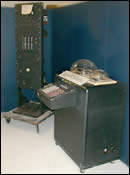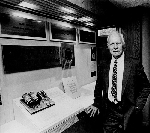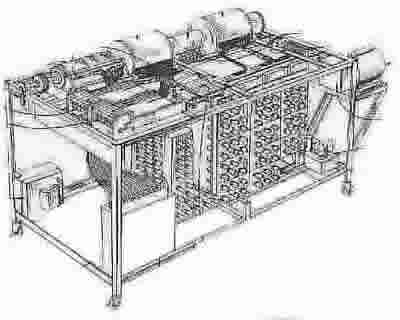click on the home button to go to the thocp home page
|
The Pre Industrial Era 1938-1939 During the decade of the 1930s, John V. Atanasoff, working as a professor of Physics at Iowa State College created a simple vacuum-tube device that took computer concepts well beyond the existing relay switch devices. In 1973, a U. S. patent for this was granted to the successors of John V. Atanasoff. The first logic circuits are now build into computers.
|
pre history | antiquity
| pre industrial era | industrial
era
1886 -
1900 - 1927
- 1938 - 1940
- 1944
| Related Articles |
| Videogame History |
| Related Resources |
![]() Around the
1850s, the British mathematician George Boole invented a new form of mathematics,
in which he represented logical expressions in a mathematical form now known
as Boolean Algebra.
Around the
1850s, the British mathematician George Boole invented a new form of mathematics,
in which he represented logical expressions in a mathematical form now known
as Boolean Algebra.
Unfortunately, with the exception of students of philosophy and symbolic logic,
Boolean Algebra was destined to remain largely unknown and unused for the better
part of a century.
But Claude
E. Shannon (USA 1916-) a graduate student of MIT (USA) combines the binary
system of Leibnitz with
the Boolean algebra.
With his proposed system it will be possible to design digital computers. The
proposed machine is an implementation of symbolic logic using relays.
|
In his paper, which was widely circulated, Shannon showed how Boole's concepts of TRUE and FALSE could be used to represent the functions of switches in electronic circuits. It is difficult to convey just how important this concept was; suffice it to say that Shannon had provided electronics engineers with the mathematical tool they needed to design digital electronic circuits, and these techniques remain the cornerstone of digital electronic design to this day.
![]() Konrad
Zuse (Germany 1910-1998) of Berlin, with assistance from Helmut
Schreyer, completes a prototype mechanical binary programmable calculator,
originally called the "V1" but retroactively renamed "Z1"
after the war. It works with floating point numbers having a 7-bit exponent,
16-bit mantissa, and a sign bit. The memory uses sliding metal parts to store
16 such numbers, and works well; but the arithmetic unit is less successful.
Konrad
Zuse (Germany 1910-1998) of Berlin, with assistance from Helmut
Schreyer, completes a prototype mechanical binary programmable calculator,
originally called the "V1" but retroactively renamed "Z1"
after the war. It works with floating point numbers having a 7-bit exponent,
16-bit mantissa, and a sign bit. The memory uses sliding metal parts to store
16 such numbers, and works well; but the arithmetic unit is less successful.
The program is read from punched tape -- not paper tape, from discarded 35 mm
movie film. Data values can be entered from a numeric keyboard, and outputs
are displayed with electric lamps.
Despite certain mechanical engineering problems it is the ancestor of all modern machines: binary, with today's standard separation of storage and control. His 1936 patent application (Z23139/GMD Nr. 005/021) suggests what is known as "von Neumann" architecture (reinvented 1945), with program and data modifiable in storage.(2)
Allan Turing publishes his influential paper "On Computable Numbers" in 'the proceedings' published by "the London Mathematical Society"
This paper solves a mathematical problem, but the solution is achieved by reasoning (as a mathematical device) about the theoretical simplified computer known today as a Turing machine.
![]() One of the
first computer games: "Odyssey"
is written by Ralph Baer. It takes until 1972 until
an attempt is made to commercialize the game. But there is no success in selling
the game, too few people had a computer where the game could run on.
One of the
first computer games: "Odyssey"
is written by Ralph Baer. It takes until 1972 until
an attempt is made to commercialize the game. But there is no success in selling
the game, too few people had a computer where the game could run on.
![]() Samsung is
set up by Byung-Chull Lee in Taegu, Korea.
Samsung is
set up by Byung-Chull Lee in Taegu, Korea.

![]() The
Electronic Accumulator is invented by Joseph Desch and Robert Mumma, the Electronic
Accumulator is a major leap in technology. For the first time, with this machine,
numbers are counted electronically using vacuum tubes, instead of mechanically.
This seemingly simple difference greatly increased the speed and ease with which
data can be manipulated.
The
Electronic Accumulator is invented by Joseph Desch and Robert Mumma, the Electronic
Accumulator is a major leap in technology. For the first time, with this machine,
numbers are counted electronically using vacuum tubes, instead of mechanically.
This seemingly simple difference greatly increased the speed and ease with which
data can be manipulated.
On the picture at left the accumulator

![]() January
1: Hewlett Packard is founded by William
Hewlett and David Packard. the story goes that a flip
of a coin decided who's name would come first.
January
1: Hewlett Packard is founded by William
Hewlett and David Packard. the story goes that a flip
of a coin decided who's name would come first.
Their first product is an audio oscillator built in a garage in Palo Alto (California
USA) for Walt Disney's animation picture Fantasia(18). This
is a better and cheaper product then the one of their competition. And the coming
30 years HP will be the largest firm producing test and measurement devices.
Only in 1966 HP will start operating on the computer market and much later on
the mini and mainframe market. With the consumers HP will be primarily known
for its laser printers and inkjet printers.

![]() On
September 9 George R. Stibitz, generally
known as the initiator of data communication and computer networks, makes
a call to a computer in New York a distance of some hundreds of kilometers.
He does this with a teletype console, a kind of mechanical type machine connected
to a telephone line. The "Model K" at the other side rattles for some
time as well. The program that ran at the other side then sends the result back.
It all takes less than a minute. For comparison: a human calculator will do
the same in more than 15 minutes.
On
September 9 George R. Stibitz, generally
known as the initiator of data communication and computer networks, makes
a call to a computer in New York a distance of some hundreds of kilometers.
He does this with a teletype console, a kind of mechanical type machine connected
to a telephone line. The "Model K" at the other side rattles for some
time as well. The program that ran at the other side then sends the result back.
It all takes less than a minute. For comparison: a human calculator will do
the same in more than 15 minutes.
The machine is built on a kitchen table, again. The 'model
K' computer is constructed from relays (electronic switches) salvaged
out of telephone exchanges. The machine can do various calculations. It produces
the noise of 100 knitting ladies because of the clattering switches. The picture
shows Stibitz next to his binary adder.
One of the major computational problems at Bell Telephone Laboratories was in the domain of complex numbers. Stibitz' first full-scale electromagnetic relay calculator solved this problem and was named the Complex Number Calculator (later the Bell Labs Model 1). A year later this machine was the first to be used remotely over telephone lines, setting the stage for the linking of computers and communication systems, time-sharing, and eventually networking. A teletype was installed in a hallway outside the meeting rooms for the annual American Mathematical Society conference at Dartmouth College, and connected to the Complex Calculator in New York. Among the people who took the opportunity to try out the system were Norbert Wiener and John Mauchly.
![]() Richard Bloch
(1922-2000) teaches programming to Grace Hopper, who later will co-develop COBOL.
Bloch, as chief operations officer at Harvard's Computation Laboratory, played
a key role in the development of the Mark I digital computer and invented the
parity check for automatic error detection.
Richard Bloch
(1922-2000) teaches programming to Grace Hopper, who later will co-develop COBOL.
Bloch, as chief operations officer at Harvard's Computation Laboratory, played
a key role in the development of the Mark I digital computer and invented the
parity check for automatic error detection.
![]() One of the
first full electronic computers is constructed at the AT&T (Bell) laboratory.
They apply for the first time binary calculus on a computer and invent with
this the first digital computer. This method means a drastic change in the course
of computing development.
One of the
first full electronic computers is constructed at the AT&T (Bell) laboratory.
They apply for the first time binary calculus on a computer and invent with
this the first digital computer. This method means a drastic change in the course
of computing development.
![]() The first electronic
computer with vacuum tubes is finalized by John
V Atanasoff (USA 1903 - 1995) en Clifford
Berry (USA ? - 1963) from the Iowa State College (now the Iowa State University),
Ames, Iowa, USA. This machine, a prototype 16-bit adder, will never reach the
production stage. But the ABC contained concepts that would appear later in
"modern computers" -- the ALU and rewriting memory.
The first electronic
computer with vacuum tubes is finalized by John
V Atanasoff (USA 1903 - 1995) en Clifford
Berry (USA ? - 1963) from the Iowa State College (now the Iowa State University),
Ames, Iowa, USA. This machine, a prototype 16-bit adder, will never reach the
production stage. But the ABC contained concepts that would appear later in
"modern computers" -- the ALU and rewriting memory.
In later years much controversy will arise about who invented the first digital
electronic computer. At a court the judge will decide in Atanasoff's favor.
He did not enjoy much of this verdict because he died soon after.

![]() Zuse and Schreyer
begin to work on the "V2" (later "Z2"), which will combine
the Z1's existing mechanical memory unit to a new arithmetic unit using relay
logic. The project is interrupted for a year when Zuse is drafted.
Zuse and Schreyer
begin to work on the "V2" (later "Z2"), which will combine
the Z1's existing mechanical memory unit to a new arithmetic unit using relay
logic. The project is interrupted for a year when Zuse is drafted.
(Zuse is a friend of Werner von Braun, who will later develop the *other* "V2",
and after that, play a key role in the US space program.)
![]() Helmut Schreyer
completes a prototype 10-bit adder using vacuum tubes, and a prototype memory
using neon lamps.
Helmut Schreyer
completes a prototype 10-bit adder using vacuum tubes, and a prototype memory
using neon lamps.
![]() A team of mathematicians
and scientists are assigned by British Secret Service to develop a machine to
crack the German's code ENIGMA. The result will be COLOSSUS,
the first electric digital computer in 1943. (17)
A team of mathematicians
and scientists are assigned by British Secret Service to develop a machine to
crack the German's code ENIGMA. The result will be COLOSSUS,
the first electric digital computer in 1943. (17)
![]()
| Last Updated on April 14, 2004 | For suggestions please mail the editors |
Notes & References
| 1 | courtesy http://www.daytonhistory.org/archive_highlights.htm |
| 2 | ref: Juergen Schmidhuber |
| 3 | TechKnowlogy Inc. 1992 : 1945 |
| 4 | Nico Baaijens 1995 |
| 5 | TechKnowlogy Inc. 1992 |
| 6 | http://www.abelard.org/turpap2/turpap2.htm |
| 9 | courtesy IBM corp |
| 10 | Reviste Ingenieria, Madrid
1907. p8; "I sobre un Sistema de Notationes y Simbola Destinados a Facilitar la Descripcion de la Maquinas" |
| 11 | austrian patent, Nr. 179 807, 1906, Title Page and Drawing , ref: sea_uni_lintz |
| 12 | Space Telegraphy. USA Patent Office NR 879 532, 1908. picture 2 ref: sea_uni_lintz |
| 13 | (Belden T.G. \& M.R.: The Lengthening Shadow. Little, Brown and Co., Boston 1962, S.~144/145 ) |
| 14 | ref: WWW.MAXMON.COM |
| 15 | ref: Stephen White |
| 16 | hagar.up.ac.za/catts/learner/andria/ |
| 17 | Marian Bozdoc, Auckland NZ, www.mbdesign.net |
| 18 | www.computable.nl |
| 19 | taken from www.maxframe.com/HISTORY.HTM |